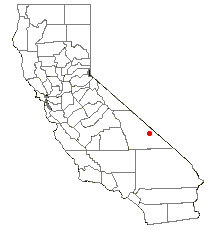Timbisha

The Timbisha ("rock paint")[1] are a Native American tribe federally recognized as the Death Valley Timbisha Shoshone Band of California.[2] They are known as the Timbisha Shoshone Tribe[1] and are located in south central California, near the Nevada border.[3] As of the 2010 Census the population of the Village was 24. The older members still speak the ancestral language, also called Timbisha.
History

The Timbisha have lived in the Death Valley region of North America for over a thousand years. In 1933 President Herbert Hoover created Death Valley National Monument, an action that subsumed the tribe's homeland within park boundaries. Despite their long-time presence in the region, the proclamation failed to provide a homeland for the Timbisha people. After unsuccessful efforts to remove the band to nearby reservations, National Park Service officials entered into an agreement with tribal leaders to allow the Civilian Conservation Corps to construct an Indian village for tribal members near park headquarters at Furnace Creek in 1938. Thereafter tribal members survived within monument boundaries, although their status was repeatedly challenged by monument officials. They also lived in the Great Basin Saline Valley and northern Mojave Desert Panamint Valley areas of present-day southeastern California.
Population
Estimates for the pre-contact populations of most native groups in California have varied substantially. (See Population of Native California.) Alfred L. Kroeber put the combined 1770 population of the Timbisha (Koso) and Chemehuevi at 1,500.[4] He estimated the population of the Timbisha and Chemehuevi in 1910 as 500.[4] Julian Steward's figures for Eastern California are about 65 persons in Saline Valley, 150-160 persons in Little Lake (springs) and the Coso Range, about 100 in northern Panamint Valley, 42 in northern Death Valley, 29 at Beatty, and 42 in the Belted Range.[5]
Tribal Recognition
With the help of the California Indian Legal Services, Timbisha Shoshone members led by Pauline Esteves and Barbara Durham began agitating for a formal reservation in the 1960s. The Timbisha Shoshone Tribe was recognized by the US government in 1982.[6] In this effort, they were one of the first tribes to secure tribal status through the Bureau of Indian Affairs' Federal Acknowledgment Process.
Reservation Land and Residence
The tribe's reservation, the Death Valley Indian Community, was established in 1982. Located within Death Valley National Park at Furnace Creek in Death Valley, Inyo County, California.[3] In 1990 it was 40 acres (0.16 km2) in size and had a population of 199 tribal member residents.[7]
Despite their federal tribal recognition and diminutive 1982 reservation, the Timbisha still faced difficulty and conflict with the Death Valley National Park's National Park Service in regaining more of their ancestral lands within the Park. After much tribal effort, federal politics, and mutual compromise, the Timbisha Shoshone Homeland Act of 2000 finally returned 7,500 acres (30 km2) of ancestral homelands to the Timbisha Shoshone tribe.[3]
Currently the Timbisha Shoshone Tribe consists of around 300 members, usually 50 of whom live at the Death Valley Indian Community at Furnace Creek within Death Valley National Park. Many members spend the summers at Lone Pine in the Owens Valley to the west.
Names
The Timbisha have been known as the California Shoshoni,[8] Death Valley Shoshone,[9] Panamint Shoshone[10] or simply Panamint. Julian Steward distinguished Death Valley Shoshone from the Kawaiisu in southern Death Valley. Harold Driver recorded two Panamint subgroups in Death Valley, the o'hya and the tu'mbica in 1937.[9]
In the Indian Entities Recognized and Eligible To Receive Services From the United States Bureau of Indian Affairs periodically listed in the Federal Register, their name is presented as "Timbi-Sha", but this is a typographical error and ungrammatical in Timbisha. The tribe[11] never hyphenates its name. Both the California Desert Protection Act [12] and the Timbisha Shoshone Homeland Act[13] spell their name correctly.
Notes
- 1 2 "Timbisha Shoshone Tribe of Death Valley" (PDF). National Park Service. Retrieved 10 December 2009.
- ↑ The name has been widely misspelled as Timbi-Sha. This, however, is an impossible spelling since timbisha is from tɨm "rock" and pisa "paint" and cannot be divided into Timbi-sha.
- 1 2 3 "California Indians and Their Reservations". SDSU Library and Information Access. Archived from the original on 5 February 2009. Retrieved 10 December 2009.
- 1 2 Kroeber (1925), p. 883
- ↑ Julian Steward, Basin-Plateau Aboriginal Sociopolitical Groups (1938, Smithsonian)
- ↑ Pritzker, 242
- ↑ Pritzker, 241
- ↑ Hinton, 30
- 1 2 Thomas, et al, 280,
- ↑ Miller, 99
- ↑ "?". Schat.net. Retrieved 3 September 2010.
- ↑ "The California Desert Protection Act". Timbisha Shoshone Tribe. Retrieved 3 September 2010.
- ↑ "Timbisha Shoshone Homeland Act" (PDF). Retrieved 3 September 2010.
See also
References
- Hinton, Leanne. Flutes of Fire. Berkeley, CA: Heyday Books, 1994. ISBN 0-930588-62-2.
- Miller, Wick R. "Numic Languages." d'Azevedo, Warren L., Volume Editor. Handbook of North American Indians, Volume 11: Great Basin. Washington, DC: Smithsonian Institution, 1986. ISBN 978-0-16-004581-3.
- Pritzker, Barry M. A Native American Encyclopedia: History, Culture, and Peoples. Oxford: Oxford University Press, 2000. ISBN 978-0-19-513877-1.
- Thomas, David Hurst, Lorann S. A. Pendleton, and Stephen C. Cappannari. "Western Shoshone." d'Azevedo, Warren L., Volume Editor. Handbook of North American Indians, Volume 11: Great Basin. Washington, DC: Smithsonian Institution, 1986. ISBN 978-0-16-004581-3.
Additional reading
- Crum, Steven J. (1998), "A Tripartite State of Affairs: The Timbisha Shoshone Tribe, the National Park Service, and the Bureau of Indian Affairs, 1934–1994," American Indian Culture and Research Journal, 22(1): 117-136).
- Haberfeld, Steven (2000), "Government-to-Government Negotiations: How the Timbisha Shoshone Got Its Land Back,” American Indian Culture and Research Journal, 24(4): 127–65. (Author, as of 2009, is exec. dir., Indian Dispute Resolution Service, Sacramento,CA.)
- Miller, Mark E. (2004), Forgotten Tribes: Unrecognized Indians and the Federal Acknowledgment Process (Lincoln: University of Nebraska Press, 2004). The Timbisha are one of four cases reviewed.
External links
- Timbisha Shoshone Tribe, official website
- "Back to Life", Carl Hall, San Francisco Chronicle, 7/11/99